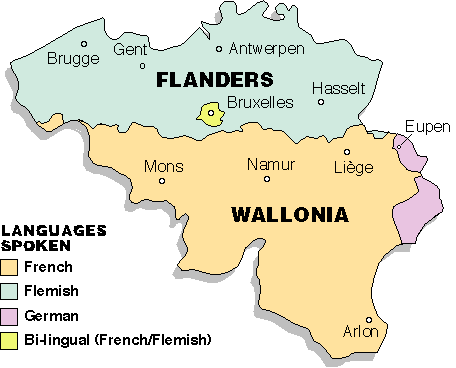|
|
Travelling east into
Wallonia from the vast maritime plains of French and Flemish Flanders, the
topography turns to rolling hills, then plateaux laced with river gorges,
before finally reaching the heavily-forested slopes of the Ardennes in the far
eastern quarter. The majority of the Walloon population live along the northern
corridor which comprises the towns of Tournai, Mons, Charleroi, Namur and
Liège, while the south remains particularly rural and secluded enough
for the abbeys of the Trappist monks to miss the hurly-burly of the twentieth
century. The coal and mineral industries have left their legacy in the once
heavily-industrialised areas around Mons and Charleroi but most of the hills of
spoil are now covered with shrubbery as monuments to a changing local
economy.
The tourist trade is currently booming in
Wallonia with the emergence of the Ardennes as an ideal
"great-outdoors" holiday destination for visitors from all over
Europe. With Mont Botrange reaching just 694 metres, the Ardennes can hardly be
called mountains, but the dark forests, moors and peat bogs constitute a
largely unspoiled, quite wild place. The towns of Marche-en-Famenne and La
Roche-en-Ardenne are the main tourist centres, and offer just about every type
of outdoor activity. The far eastern towns of Bastogne and Arlon are well
visited by Americans who want to see the cemeteries and monuments to those who
fell in the Battle of the Bulge which took place in the forbidding terrain of
the Ardennes.
Another popular tourist spot is the Meuse
valley with its spectacular gorge around Dinant and the cosmopolitan town of
Namur, the capital of Wallonia and host to the annual
"Fête de Wallonie".
Mons, another town that gained notoriety from war (but this time in the First
World War), has a beautiful town square and many fine buildings, which survived
its tumultuous past. Tournai also boasts a couple of attractive squares,
surrounded by the ubiquitous Flemish gable-ended house frontages, and is
dominated by one of the largest cathedrals in northern Europe.
Wallonia offers a rich diversity of
excellent, often very artisanal beers that defy strict categorisation by style.
There are just six surviving beer-brewing Trappist abbeys in the world, five of
these are in Belgium and three - Rochefort, Orval and Chimay seclude themselves
in the wooded hills of southern Wallonia (these should not be confused with the
commercially-made contract beers for abbeys such as Leffe, Maredsous and
Floreffe, which are so common in Belgium).
The most famous of Wallonia's beer styles
is the somewhat loosely defined saison "style", which now encompasses
too wide a spectrum of beers to be reliably descriptive of a specific character
and taste. Many of these beers, such as Saison de Pipaix, Saison de Silly and
Saison Regal, have a rich malty base with an aromatic and mouth-tingling
spiciness. Other beers, such as Saison Dupont, Saison 1900 and Saison
d'Epeautre (the latter made with spelt grain), exude a citric, spritzy
character. Different still are the literally-named Saisons d'Erezée, of
which four are brewed annually to coincide with each particular season and are
heavily spiced with seasonal herbs, spices, flowers and leaves.
"Saison" is a very old beer style which was traditionally made by
farmer-brewers in the late winter to be laid down until the summer when they
were provided as a thirst quencher to landworkers, probably forming part of
their payment. This farmhouse origin helps account for its wide variety and its
regional differences.
Wallonia possesses some very famous
breweries, such as Dubuisson (Bush Beer), Union (Cuvée de l'Ermitage,
the Grimbergen range of beers), Jupille (Jupiler) and Achouffe (La Chouffe and
McChouffe) - but many, especially the very artisanal ones - remain almost
unknown to all but the locals. We hope our book "The Beers of Wallonia
-Belgium's Best Kept Secret" and these Wallonian Beer Pages will give an
insight into the excellent, diverse range of Wallonian beers and give them a
deservedly higher profile.
DISCOVER THE "OTHER" HALF OF
BELGIUM
|

